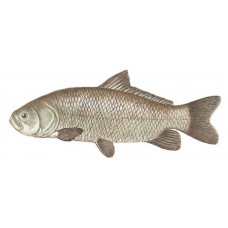Latin name
Ictiobus cyprinellus
Other names
Buffalofish, common buffalo, lake buffalo, slough buffalo, blue buffalo, baldpate, bull-nosed buffalo, brown buffalo, stubnose, pug.
Identification
The stout and deep-bodied bigmouth buffalo has a large head with a large, distinctly oblique and toothless mouth. This terminal, thin-lipped cavity tilts downward when closed, although the edge of the upper lip is almost level with the eyes. The dorsal fin is sickle-shaped, characterized by a taller lobe in the middle of the dorsum, which tapers into a shorter lobe. The entire fin extends to the caudal spine. It is the only member of the sucker family that has its mouth directly at the front of the head. The coloration may be gray, copper-olive-brown, or slate-blue on the back, and the sides are yellowish-olive, transitioning to a white belly. All fins have a blackish hue.
Distribution
Bigmouth buffalo are found only in North America, in the Nelson River basin in Hudson Bay, the lower Great Lakes, the Lake Erie basin and the Ohio and Mississippi rivers, from Ontario to Saskatchewan and Montana south to Louisiana and the Gulf of Mexico. They have also been successfully introduced in Arizona, California, and Cuba.
Habitat
Bigmouth buffalo prefer pools and backwaters of small and large rivers, and are found in lakes and reservoirs.
Size
The largest of all suckers, the bigmouth buffalo, can reach 80 pounds, although the record holder in rod and reel fishing is a 70 pound, 5 ounce fish. It usually weighs between 3 and 12 pounds and reaches 40 inches in length. Most fish live only 6 to 8 years and grow to 20 pounds.
Life history and Behavior
Adults spawn at about 3 years of age, in April or May, when water temperatures reach 60-65 °F. Adults seek out weedy areas 2 to 3 feet deep to lay eggs, which hatch after 10 to 14 days. Throughout their lives, they roam in groups and are able to tolerate temperatures up to 90 °F in water with little dissolved oxygen.
Food and feeding habits
About 90 percent of the food that bigmouth buffalo eat consists of small crustacean species.
Reproduction
No information
| Classification | |
| Phylum | Chordata |
| Class | Actinopterygii |
| Squad | Cypriniformes |
| Family | Catostomidae |
| Genus | Ictiobus |
| Species | I. cyprinellus |
| Features | |
| Conservation status | Secure |
| Habitat | Pelagic |
| Life span, years | 127 |
| Maximum body weight, kg | 36 |
| Maximum length, cm | 120 |
| Sailing speed, m/s | No information |
| Threat to people | Edible |
| Way of eating | Predator |


